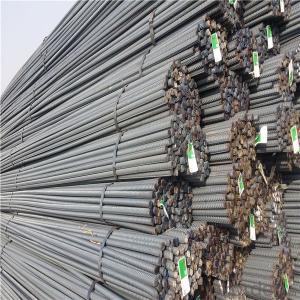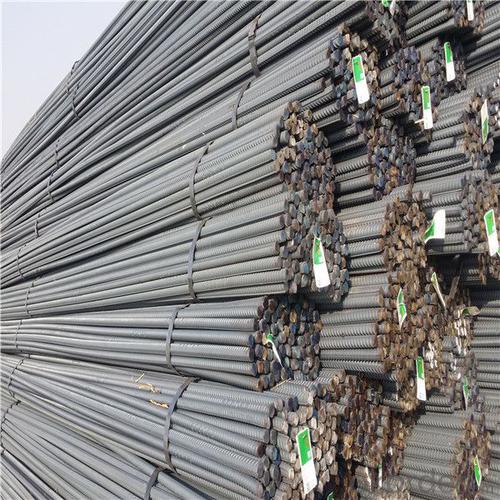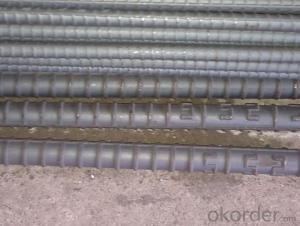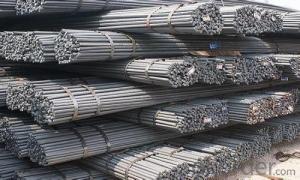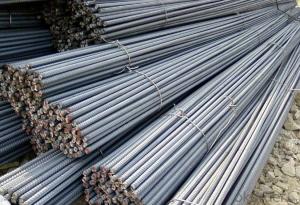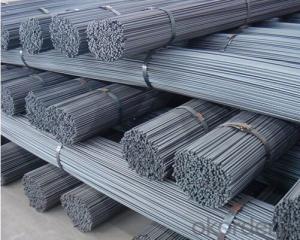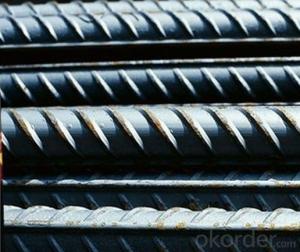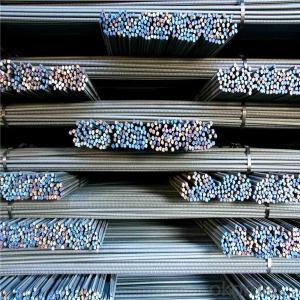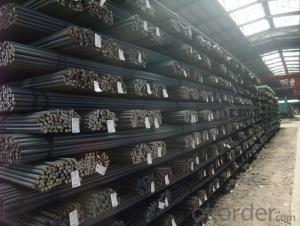Chinese manufacturer steel rebar high quality
- Loading Port:
- China main port
- Payment Terms:
- TT OR LC
- Min Order Qty:
- 1000 m.t.
- Supply Capability:
- 19865 m.t./month
OKorder Service Pledge
OKorder Financial Service
You Might Also Like
Specification
Although rebar has ridges that bind it mechanically to the concrete with friction, it can still be pulled out of the
concrete under high stresses, an occurrence that often precedes a larger-scale collapse of the structure. To prevent
such a failure, rebar is either deeply embedded into adjacent structural members, or bent and hooked at the ends to
lock it around the concrete and other rebars. This first approach increases the friction locking the bar into place while
the second makes use of the high compressive strength of concrete
Most grades of steel used in rebar cannot accept welding; such as, to adjacent steel plates or as means to
bind single pieces of rebar together. However, special grades of rebar steel and welding rods make welding
by expert welders possible.
Our Advantage:
High quality steel products from 1 class mills in China
Reasonable price
Professionalism of the products
On-time delivery
Complete documents and certificates
Sincere service to meet our clients' requirements
Product Description :
Chemical composition (%): | Steel | C | Si | Mn | P | S | Ceq | ||||
HRB335 |
0.25 |
0.80 |
1.60 |
0.045 |
0.045 | 0.52 | |||||
HRB400 | 0.54 | ||||||||||
HRB500 | 0.55 | ||||||||||
Mechanical properties | Steel | Rel/ MPa | Rm/ MPa | A/ % | Agt/ % | ||||||
≥ | |||||||||||
HRB335 | 335 | 455 | 17 |
7.5 | |||||||
HRB400 | 400 | 540 | 16 | ||||||||
HRB500 | 500 | 630 | 15 | ||||||||
Package: | Standard export packing or as customer's request | ||||||||||
Application: | Construction, building, bridge, road. ect | ||||||||||
Payment terms | 1).100% irrevocable L/C at sight. | ||||||||||
Delivery time | 15-30 days after receipt of L/C or deposit by T/T | ||||||||||
Features
1、Pure steel quality, stable chemical contents, small tolerance.
2、Constant Quality, good drawing performance.
3、High dimension accuracy degree, accuracy degree of Level C up to 80%, smooth surface, less scale, easy to be pickled.
4、Automatic bundling with 4 lines by Machine in tidy and good looks
5、Big high quality percentage, small coil percentage, and heavy coil weight for Hard Coil.
6、High sorbitizing percentage.
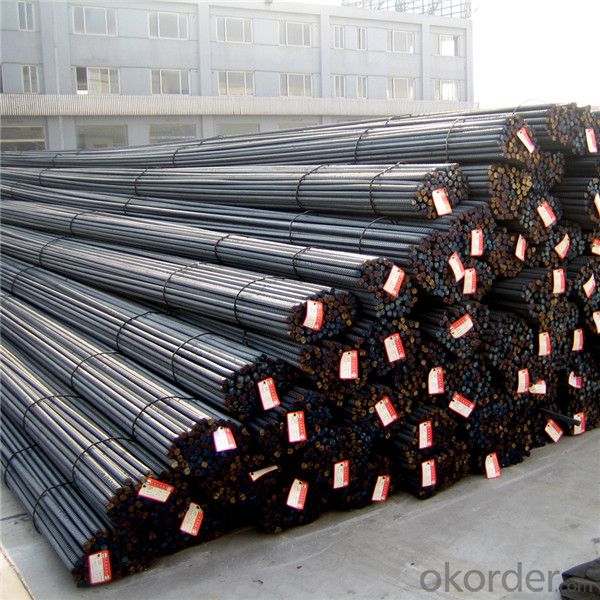
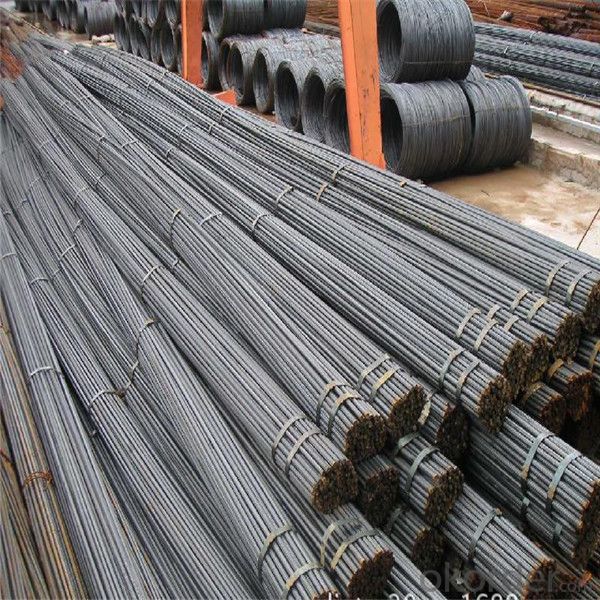
Packing:
In bundles, each bundle weight 3.5 tons. Load by container or by bulk verssel.
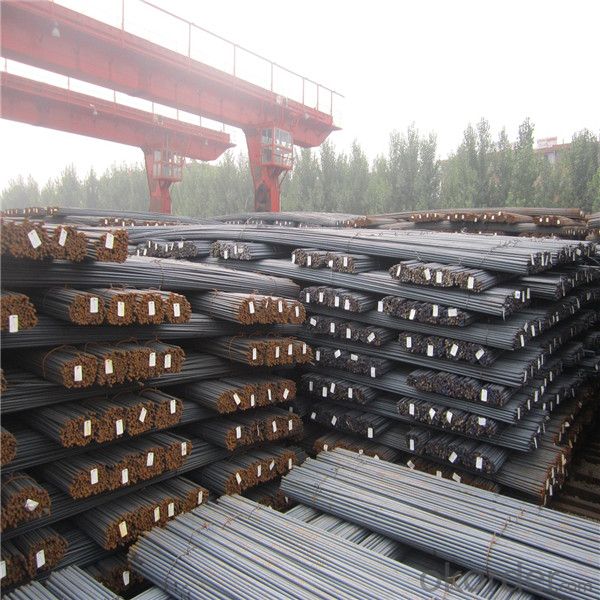

Our service
(1) We cooperate with famous factories with advanced equipment and well trained workers.
(2) We can provide factory price with trading company service.
(3) We continuously work on the improvement of our processes, guaranteeing consistently high standards
of quality to keep none compensation.
(4) We guarantee 24 hours response and 48 hours solution providing service.
(5) We accept small order quantity before formal cooperation.
(6) We deliver the agreed quality at the agreed time, reacting to changes in customer wishes in a flexible way.
(7) Due to our volume and selling power, we have excellent freight rates with shipping lines.
(8) We strive to always be fair and honest in our dealings with customers.
(9) We strive to work together with customers to achieve much more than we can achieve alone.
(10) Through our passion and commitment we aim to be a market leader in all our key markets. To maintain
our position as market leader we must continue to add value in all that we do.
FAQ:
1.Q: What's your MOQ(minimum order quantity)?
A: One full container, mixed acceptable .
2. Q: What's your packing methods?
A: Packed in bundle or bulk ..
3. Q: How can I buy CNBM products in my country?
A:Please send us an inquiry or email ,we will reply to you if there is distributor in your country
4. Q: Can we visit your factory?
A: Warmly welcome. Once we have your schedule, we will arrange the professional sales team to follow up your case.
5. Q: How long does it take to get the product if i place an order?
A:With the process of your requirements,we will pack and deliver in 3-7 days. If it is by sea shipment,it will take 15-45 days depending on different locations
- Q: Can steel rebars be used in structures with high resistance to creep?
- Steel rebars are suitable for structures that require high resistance to creep. They are widely utilized in reinforced concrete structures, contributing to their strength and durability. Creep refers to the gradual deformation of a material when subjected to continuous stress over time. Although steel does experience some creep, its creep rate is relatively low compared to materials like concrete or timber. Moreover, incorporating rebars in reinforced concrete structures aids in load distribution and mitigates the impact of creep by enhancing rigidity and minimizing stress on the concrete. Consequently, steel rebars can be efficiently employed in structures that demand resistance to creep, provided that they are appropriately designed and installed.
- Q: Can steel rebars be used in precast or prestressed concrete?
- Yes, steel rebars can be used in both precast and prestressed concrete. Rebars are commonly used in these construction methods to provide reinforcement and enhance the strength and durability of the concrete structures.
- Q: How are steel rebars protected from corrosion?
- Steel rebars are protected from corrosion through the use of various methods such as applying protective coatings, using corrosion inhibitors, and employing cathodic protection systems.
- Q: What are the cost implications of using steel rebars in construction?
- The cost implications of using steel rebars in construction can vary depending on several factors. Steel rebars are generally more expensive than alternative materials such as concrete, but they offer several advantages that can offset the higher upfront cost. Using steel rebars can lead to quicker and easier construction processes, as they are readily available and can be easily installed. This can result in reduced labor costs and shorter construction timelines, which can be beneficial for overall project costs. Moreover, steel rebars offer excellent strength and durability, making them a reliable choice for reinforcing concrete structures. They can enhance the structural integrity of buildings, bridges, and other infrastructure, potentially reducing the need for costly repairs or maintenance in the long run. However, it is important to consider the potential costs associated with corrosion protection for steel rebars, as they are prone to rusting when exposed to moisture or harsh environments. Implementing appropriate measures, such as proper coating or using stainless steel rebars, can help mitigate these costs. Overall, while steel rebars may incur higher initial expenses, their numerous advantages in terms of strength, durability, and construction efficiency often make them a cost-effective choice in the long term.
- Q: How do steel rebars resist fatigue and cyclic loading?
- Steel rebars resist fatigue and cyclic loading due to their high tensile strength and ductility. The presence of reinforcing bars in concrete structures helps to distribute the applied loads more effectively, preventing localized stress concentrations. The steel rebars can absorb and dissipate energy through their ability to deform elastically, which helps to withstand repeated loading cycles without failure. Additionally, the surface properties of rebars can be enhanced through various treatments, such as galvanizing or epoxy coating, which provide extra protection against corrosion and further improve their resistance to fatigue and cyclic loading.
- Q: Can steel rebars be used in high-strength concrete?
- Yes, steel rebars can be used in high-strength concrete. In fact, they are commonly used as reinforcement in high-strength concrete structures to enhance the overall strength and durability of the concrete.
- Q: What are the guidelines for the proper storage of steel rebars on construction sites?
- Proper storage of steel rebars is crucial on construction sites to ensure their integrity and prevent any potential hazards. Here are some guidelines for the correct storage of steel rebars: 1. Select a suitable storage area: Choose a flat, stable, and well-drained area for storing steel rebars. Avoid locations prone to flooding or excessive moisture. 2. Provide adequate space: Allow enough space between rebars to prevent any contact or entanglement that may cause damage. Maintain clear aisles and paths for easy access and movement. 3. Protect against corrosion: Steel rebars should be protected from moisture and corrosion. Cover them with waterproof and UV-resistant tarpaulins or plastic sheets to shield them from rain, snow, or direct sunlight. 4. Elevate from the ground: Place the rebars on wooden supports or pallets to keep them off the ground. This prevents contact with water, dirt, or any other contaminants that could accelerate corrosion. 5. Securely stack rebars: Stack the rebars horizontally in a way that ensures stability and prevents them from rolling or falling. Place larger and heavier rebars at the bottom of the stack to provide a secure base. 6. Label and organize: Clearly label each stack with information such as size, length, and grade for easy identification. Organize the storage area by separating different sizes or types of rebars to minimize confusion and facilitate retrieval. 7. Regularly inspect and maintain: Conduct routine inspections to check for any signs of corrosion, damage, or deformation. Remove any rebars that show signs of deterioration to prevent accidents or compromised structural integrity. 8. Handle with care: When moving or transporting rebars, use appropriate lifting equipment like cranes, forklifts, or hoists. Avoid dragging or dropping them, as this can cause deformation or damage. 9. Follow manufacturer's recommendations: Consult the manufacturer's guidelines for specific storage requirements and recommended practices for the particular type of steel rebars being used. By following these guidelines, construction sites can ensure the proper storage of steel rebars, which in turn helps maintain their quality, prolong their lifespan, and guarantee the safety of workers and structures.
- Q: How are steel rebars used in reinforced concrete structures?
- Steel rebars are used in reinforced concrete structures to provide additional strength and resistance to tension forces. They are embedded within the concrete, creating a composite material that can withstand greater loads and prevent cracks from forming. The rebars act as a reinforcement, helping to distribute the applied loads evenly throughout the structure and enhancing its durability and structural integrity.
- Q: Why is the price of screw steel affected by iron ore and coal?
- At the same time, rebar is the largest type of steel in our country and is the seller's market.
- Q: Can steel rebars be bent or shaped on-site?
- Yes, steel rebars can be bent or shaped on-site using specialized equipment or tools such as rebar benders or hydraulic benders. This allows for flexibility in adjusting the rebars to fit specific construction requirements or designs.
Send your message to us
Chinese manufacturer steel rebar high quality
- Loading Port:
- China main port
- Payment Terms:
- TT OR LC
- Min Order Qty:
- 1000 m.t.
- Supply Capability:
- 19865 m.t./month
OKorder Service Pledge
OKorder Financial Service
Similar products
Hot products
Hot Searches
Related keywords
